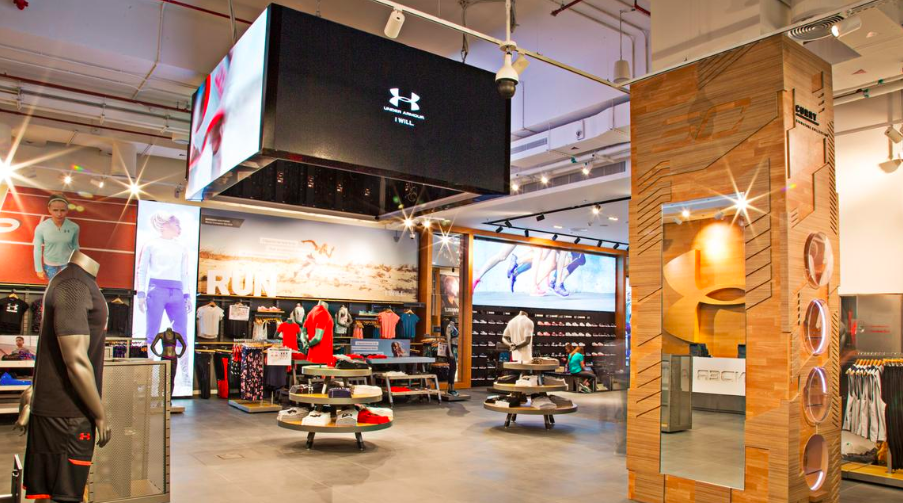Most analysts applauded the progress Under Armour is making instilling greater operational and financial disciplines under its transformation efforts. Some were also encouraged by the innovation on display Wednesday at the company’s Investor Day in Baltimore. But growth concerns, particularly in North America, and overall execution issues in the competitive landscape continued to worry many on Wall Street.
On Wednesday, shares fell $2.32, or 10.5 percent, to $19.80 with many attributing the decline to a weak forecast given by the company for 2019
The company said it expects EPS of 31 cents to 33 cents next year, on the low end of the 33-cent consensus target. Revenue growth is targeted at 3 to 4 percent in 2019, trailing the average estimate of 5 percent.
With the five-year outlook given at the event, global revenue is expected to return to a low double-digit growth rate in 2023 with mid to high single-digit five-year compounded annual growth rate (CAGR) overall seen through 2023. Annual operating margin is expected to reach a low double-digit percentage rate by 2023, improving 560 t0 700 basis points. EPS is expected to grow at a five-year CAGR of approximately 40 percent.
Some analysts remained concerned about execution issues in the years ahead as most of the improvement in margin appeared skewed toward the back end of the five-year period. Many also remain concerned over North America, with the forecast for flat growth in 2019 in the region as well as flat to low single digit CAGR over the next five years disappointing some.
The event was Under Armour’s first investor day since 2015.
On Thursday, shares fell another $1.04, or 5.3 percent, to $18.77 on those concerns. Some analysts noted that the stock was already highly-valued versus peers, having begun the year at $14.43 and reached as high as $24 on hopes of turnaround.
A few analysts, according to notes that came out following the day-long event, felt Under Armour was on the right path.
At Stifel, Jim Duffy, who has a “Buy” rating with a $30 price target on Under Armour’s stock, was impressed by the focus and discipline inherent in the presentation that has resulted from the company’s transformation efforts over the last two years. Wrote Duffy in a note, “The 2018 Investor Day featured focus, growing operational sophistication, and financial discipline providing stark contrast from the Investor Day in 2015. Also in contrast to 2015, the outlook positions the company for success.”
The event, to Duffy, underscored the extent to which Under Armour had pivoted to a consumer centric model driven by consumer insights and data. Wrote Duffy, “Product, Story, Service, and Team all orient to the “Focused Performer,” a target consumer definition that has commonality regardless of region or gender. This simplified mission is providing clarity to strategy and operations.”
He further noted that Under Armour’s overall five-year outlook will look to benefit from greater segmentation within channels, increased store footprint (both owned and third-party), a greater focus on full-price over off-price selling, pricing and supply chain optimization, and a reduction in turnaround time to 17 months from 22 months.
Duffy attributed the pressure on Under Armour’s shares Wednesday to its relatively-high multiple versus the modest revenue outlook, but he expects Under Armour will be able to track ahead of both 2019 and five-year targets. He added, “In our view, justification for a premium multiple remains unchanged and supported by the global growth opportunity. Improved focus, operational sophistication, and financial discipline only increase the probability of executing to potential.”
At KeyBanc Capital Markets, Edward Yruma, who has an “Overweight” rating and a $30 price target, was also bullish. He wrote that the five-year target of mid-single to high-single digit CAGR reflects the favorable long-term secular trends in the sports industry as well as a “more robust” focus on innovation by Under Armour.
The KeyBanc team was “very impressed” by the new product shown at the event. “Early wins” with the Hovr running platform and brand activations around Project Rock and ASAP Rocky also “give us confidence in a revenue re-acceleration,” Yruma wrote. He added, “We believe that UAA’s refined customer targeting matrix as well as a more methodical and robust development pipeline will help return the business to growth.”
But the analyst appeared more impressed by the increased focus on operational discipline brought on by the transformation process being led by COO Patrik Frisk that should support its goal to expand gross margin by 275-300 basis points by 2023. Yruma wrote, “Patience is required, but we believe absolute long-term upside could be some of the most significant in our coverage.“
At Wedbush Securities, Christopher Svezia, who maintained his “Neutral” rating with a $20 price target after the event, said Under Armour has made “”laudable progress” in supply chain and inventory areas, cost savings and overall “becoming a more efficient organization.”
After attending the company’s Investor Day, he wrote that Under Armour’s international potential supports achieving mid-to-high single digit revenue growth on a five-year CAGR. The combination of supply chain optimization, reducing off price sales, and higher mix of sales in direct-to-consumer (DTC) and to the Asia Pacific region could also support its gross margin targets.
But he questioned whether Under Armour would be able to leverage SG&A to drive its goal of EPS expanding at a five-year CAGR of approximately 40 percent. Svezia wrote, “Competition is more intense and the brand may need to invest more heavily into marketing, innovation, and international.”
Svezia was also concerned about the meager growth outlook in North America amid rising competitive pressures. He wrote, “In the end, management has made progress in turning around the company yet there is high execution risk and UAA is priced at a premium to several peers who are outperforming or have more predictable development of sales and margins. In order to become more constructive, further strengthening fundamentals, such as an acceleration in NA sales, are needed for this potential ”
At Morgan Stanley, Lauren Cassel, who has an “Equal-weight” rating on the stock with a price target of $21, was likewise encouraged by Under Armour’s improved discipline and processes, including shortening lead times by five months to 17 months. She called out Under Armour’s commitment to re-establishing a premium positioning for the brand in the U.S. with its shift away from off-price selling, as well as its renewed innovation focus across both apparel and footwear and more systematic go-to-market process designed to support “long-lasting franchises.”
But she called the low-single digit target growth target for North America on average over the next five years “disappointing for the brand’s home market” and below the 4 percent average growth expected the overall industry. The growth target depends greatly on oversized growth in the Asia Pacific region “with the economic cycle peaking.”
Cassel also felt that investors wanted to hear more details of the components of its 275-300 basis-point gross margin five-year expansion goal. Cassel wrote, “2019 guidance appears appropriately conservative, but UAA needs to show investors next year numbers are achievable before they underwrite the 5-yr story.”
Other analyst notes arriving included:
- Cowen, which has a “Market Perform” rating on Under Armour with a $21 price target, in a note said Under Armour’s presentation “was impressive with new vision, processes, innovation and financial discipline.” But lead analyst, John Kernan, also noted that the five-year target was largely in line with consensus and its own estimates and the stock already packed a high valuation relative to peers. A concern for Kernan was that earnings targets rely on a “substantial increase” in International operating margin. Wrote Kernan, “While we think the revenue targets are achievable, and may prove conservative, the margin targets, even with the benefit of supply chain efficiencies and higher AURs, place a good deal of pressure on everything going right.”
- CFRA Research downgraded Under Armour to “Strong Sell” from “Sell” and slashed its price target to $5 from $15. Analyst Camilla Yanushevsky wrote in a note, “Our downgrade reflects our skepticism of the timeline of UAA’s turn-around narrative following today’s Investor Day. We remain concerned with UAA’s ability to tighten inventories (down only 0.6 percent in Q3) without significant brand degradation from aggressive off-price selling. That said, we are also wary of achievement of Under Armour’s five-year revenue CAGR projections for direct-to-consumer retail (22 percent to 24 percent) and digital (28 percent to 30 percent) given direct-to-consumer sales declined in Q3, a possible indication, in our view, of lukewarm response to product assortments.”
- At Canaccord Genuity, Camilo Lyon, who has a “Sell” rating on Under Armour’s stock with a price target of $13, favored the focus on profitability heard at Investor Day. But he wrote that the guidance suggests that the targeted earnings growth will “likely be more back half weighted” over the five-year plan and the stock “appears highly expensive for the amount of work that needs to be done to hit these targets in the out years.” Lyon also doesn’t believe Under Armour is “the growth company it was years ago.” He noted that his team wasn’t invited to the event in Baltimore due to his firm’s negative view on the stock and wasn’t able to see the talked-about innovation that may spur growth. Wrote Lyon, “We would welcome having more confidence in the company’s ability to hit these targets; however, not seeing the company’s innovation or the depth of its pipeline prohibits us from changing a critical pillar of our thesis.”
- Raymond James, which maintained its “Underperform” rating on Under Armour, questioned whether the ramp up to double-digit annual revenue growth by 2023 was feasible. Analyst Dan Wewar wrote, “From which brands does Under Armour expect to steal market share? Nike, Adidas, The North Face?…These are great competitors that we do not see losing market share. Further, the rapid revenue growth expected by 2023 will be heavily leveraged on Asia Pacific, while North America is only expected to grow revenue at a five-year CAGR of 1-3 percent.”
- Bank of America Merrill Lynch maintained its “Underperform” rating on Under Armour but raised its price target from $10 to $15. Analyst Robert Ohmes was encouraged by Under Armour’ commitment to improving its EBIT margin is from 3 percent in 2018 to 10 percent by 2023.
- At Oppenhemer, Brian Nagel, who has a “Perform “rating on Under Armour’s stock, called out the brand’s renewed focus on premium selling, including moderating growth internationally to ensure a premium positioning in the Asia Pacific region. He also called out the shift to focus back on the core “Focused Performer” consumer after “testing the brand in the athleisure space without much real success.” Nagel still felt Under Armour faces challenges fully reaping the benefits from its three-year reset that ends in 2019. He wrote, “For us, the key message from CEO Kevin
Plank and his team at yesterday’s event on the future growth trajectory of the company was: UAA is building a business for the long term, focused on healthy and strategic growth. While we are quite encouraged by indications of stabilization and improved controls at the company, given internal challenges and increased competition, we
remain in wait-and-see mode with UAA.”
Image courtesy Under Armour
















